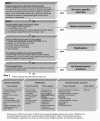The cost-effectiveness of a treatment-based classification system for low back pain: design of a randomised controlled trial and economic evaluation
- PMID: 20346133
- PMCID: PMC2859390
- DOI: 10.1186/1471-2474-11-58
The cost-effectiveness of a treatment-based classification system for low back pain: design of a randomised controlled trial and economic evaluation
Abstract
Background: Systematic reviews have shown that exercise therapy and spinal manipulation are both more effective for low back pain (LBP) than no treatment at all. However, the effects are at best modest. To enhance the clinical outcomes, recommendations are to improve the patient selection process, and to identify relevant subgroups to guide clinical decision-making. One of the systems that has potentials to improve clinical decision-making is a treatment-based classification system that is intended to identify those patients who are most likely to respond to direction-specific exercises, manipulation, or stabilisation exercises.
Methods/design: The primary aim of this randomised controlled trial will be to assess the effectiveness of a classification-based system. A sample of 150 patients with subacute and chronic LBP who attend a private physical therapy clinic for treatment will be recruited. At baseline, all participants will undergo a standard evaluation by trained research physical therapists and will be classified into one of the following subgroups: direction-specific exercises, manipulation, or stabilisation. The patient will not be informed about the results of the examination. Patients will be randomly assigned to classification-based treatment or usual care according to the Dutch LBP guidelines, and will complete questionnaires at baseline, and 8, 26, and 52 weeks after the start of the treatment. The primary outcomes will be general perceived recovery, functional status, and pain intensity. Alongside this trial, an economic evaluation of cost-effectiveness and cost-utility will be conducted from a societal perspective.
Discussion: The present study will contribute to our knowledge about the effectiveness and cost-effectiveness of classification-based treatment in patients with LBP.
Trial registration number: NTR1176.
Figures
References
-
- Biering-Sorensen F. A prospective study of low back pain in a general population. I. Occurrence, recurrence and aetiology. Scand J Rehabil Med. 1983;15:71–79. - PubMed
-
- Waddell G. Subgroups within "nonspecific" low back pain. J Rheumatol. 2005;32:395–396. - PubMed
-
- Poitras S, Blais R, Swaine B, Rossignol M. Management of work-related low back pain: a population-based survey of physical therapists. Phys Ther. 2005;85:1168–1181. - PubMed
Publication types
MeSH terms
LinkOut - more resources
Full Text Sources
Miscellaneous



